Modes of Reproduction
- Books Name
- Class-8 Science Book
- Publication
- PathSet Publications
- Course
- CBSE Class 8
- Subject
- Science
Modes of Reproduction
- Several processes such as circulation of blood, digestion and respiration are essential for the survival of human beings and other animals.
- Similarly, reproduction is essential to maintain continuity in the species.
- If reproduction in animals does not take place, no similar kind of organisms will be present on the earth generation of the generation.
What is Reproduction?
Reproduction is the process of continuation of similar kinds of individuals, generation after generation. In this process, all living beings produce their young ones for continuity of life on the planet earth. In this process, an organism gives birth to a new individual of its own kind. It is a biological process in which new organisms are produced from existing organisms. All organisms reproduce (whether plants, animals, or microorganisms) to keep their species alive.
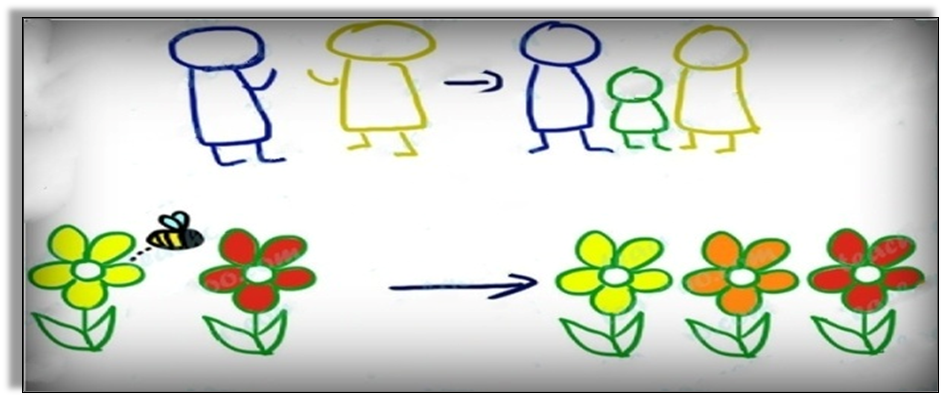
Why is Reproduction important?
- Organisms reproduce to keep their species alive
- If organisms do not reproduce, species will become extinct
- So reproduction is necessary for the continuation of species(organisms) generation after generation
Modes of Reproduction in Animals
There are two modes of reproduction in animals:
- Sexual Reproduction
- Asexual Reproduction
Similarities between Reproduction in Plants and Animals
- Plants and animals can both undergo the sexual and asexual processes of reproduction.
- Just like plants, in animals, males and females have different reproductive organs.
- In both plants and animals, the zygote is formed when the male and female gametes fuse together and hence the zygote develops into a new individual.
Reproduction in Human Beings
- In Human Beings, Sexual Reproduction is used to reproduce
- We know that in Sexual Reproduction,
- Male and Female Gametes Fuse to form Zygote. This Zygote later develops into New Individual
Steps
- In males, Testes produce male gametes called Sperms
- In females, Ovaries produce female gametes called Eggs (or Ova)
- Nuclei of Sperms and Ova fuse (combine). This process is called fertilization
- After fertilization, the zygote is formed (fertilized egg is called a zygote)
- Zygote cells divide repeatedly to form a ball of cells
- These balls of cells form tissues and organs, This is called embryo
- Embryo further develop in the wall of the uterus
- When all body parts of an embryo can be fully identified, it is called foetus
- When foetus is ready, the mother gives birth to a baby
Procedure for Reproduction in Humans
- Male sperm cells enter the body through the vagina
- They go into the uterus and from there into oviducts
- Ovaries produce egg or ova
- Ovaries release a single egg every month to the oviduct
- In the oviduct, one of the male sperm cells fertilize with the ova to form the zygote
- Zygote multiples repeatedly to form an embryo
- The embryo develops into foetus in a few months in the uterus of the female
- After a few months, the baby is formed
Types of Reproduction:-
Sexual reproduction:
The process in which two parents participate in producing their offspring. Sexual reproduction is a natural way of reproduction in humans, animals and the majority of plants. It takes place when male and female gametes fuse together to form a new organism.
Asexual reproduction:
The process in which a single parent divides itself and produces its offspring. The new individuals produced are genetically and physically identical to each other, i.e., they are the clones of their parents.
Sexual Reproduction
- Books Name
- Class-8 Science Book
- Publication
- PathSet Publications
- Course
- CBSE Class 8
- Subject
- Science
Sexual Reproduction
The type of reproduction that begins with the fusion of male and female gametes is called Sexual Reproduction.
Reproductive Parts in Humans
Male Reproductive Organs
The male reproductive system provides the sperm (male gametes) for fertilization. The male reproductive organs include the following:
Penis
It is a cylinder-shaped organ containing a small opening at its top. It secretes semen which contains the male gametes or sperms.
Scrotum
It is a sac-like structure present behind the penis. The testicles or testes are present in this organ. It provides them with the right temperature so that they can produce sperms.
Testes
Most males have a pair of testis (testes) or testicles. The testes consist of coiled tube-like structures that produce sperms. The testes also generate the male sex hormone or the testosterone that causes puberty in males.
Urethra
It is a tube-like structure that allows the flow of semen that contains sperms outside the body. The urethra and penis both are also a part of the male urinary system.
Vas Deferens
It is a tube that carries the sperms from the testicles to the urethra.
Prostate Gland
It is a gland located under the urinary bladder. It secretes prostate fluid which makes up one-third content of semen. This fluid contains some enzymes, zinc and citric acid.
Seminal Vesicles
They have a pouch-like structure. They are located above the prostate gland and connect with the vas deferens. They also secrete a fluid that provides nourishment to the sperms.
Male Sex Hormone or Testosterone
The testes produce testosterone and the pituitary gland controls how much testosterone will be produced. This hormone is responsible for the development of male sex organs and the development of secondary sexual characters in males during puberty such as deepening of voice and growth of facial and body hair.
The Sperm Cell
The testes secrete millions of sperm cells together. A sperm comprises of a single cell and has a specific structure with three main parts as given below:
Head: It consists of the nucleus which contains the DNA information of the cell.
Middle Part:: It is packed with cell organelles called Mitochondria. The mitochondria are responsible for producing energy in the cell. Hence, sperm uses this energy to move.
Tail: It allows the sperm cell to travel at a fast pace.
Female Reproductive Organs
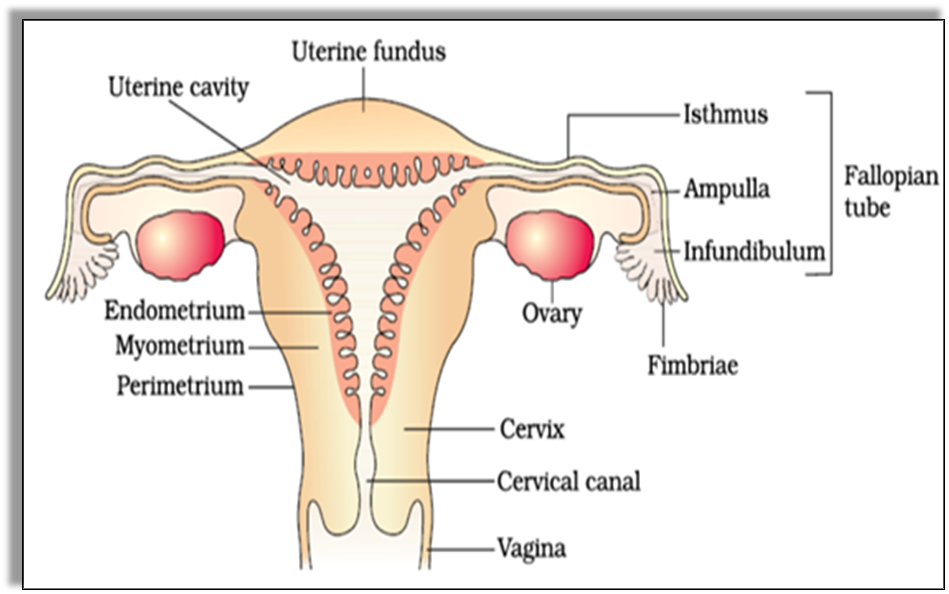
The female reproductive system provides the eggs (female gametes) for fertilization. The female reproductive organs are:
Ovaries
The female reproductive system comprises a pair of ovaries. These are the main female sex organs and are responsible for the production of female gametes called Eggs or Ova (ovum – singular) and female hormones. The ova or female eggs also consist of a single cell.
Estrogen and Progesterone
These are hormones or chemical substances produced by the ovaries. These hormones are responsible for the development of the female reproductive organs and the secondary sexual characteristics in women such as the development of breasts and body hair.
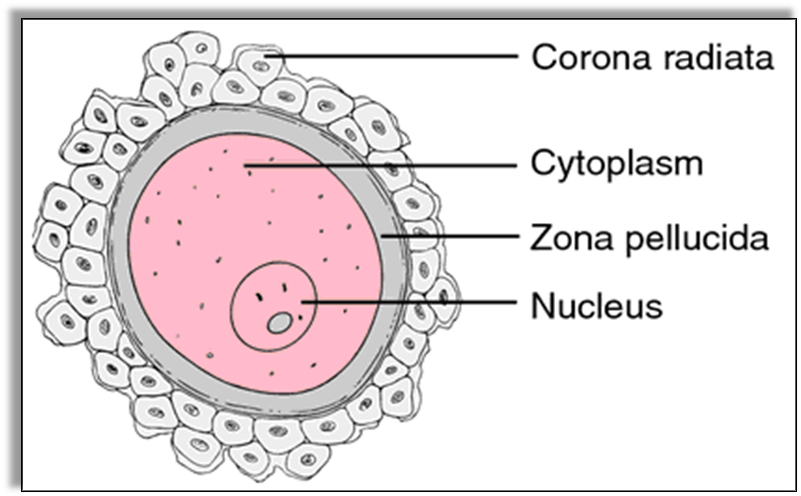
Oviduct or Fallopian Tubes
These are two funnel-shaped structures that extend from the superior right and left corners of the uterus to the edge of the ovaries. The ovaries release one egg every month into the oviducts. The oviducts consist of cilia that carry the ovum from the oviduct to the uterus.
Uterus
It is an inverted pear-shaped organ that allows the development of the fertilized egg into a human baby. The uterus connects with an opening called Cervix that connects it to the vagina.
Vagina
It is a muscular tube-like structure that connects with the cervix. It acts as the receptor of the penis and allows the movement of sperms to the fallopian tubes and uterus. It also allows delivery of the foetus during the birth of the child.
Menstrual Cycle
When females hit puberty, they start producing mature eggs every month indicating the ability to reproduce. This process is called the menstrual cycle. In this cycle, the ovaries produce an egg every month that travels to the uterus and attaches to its lining. If the egg is not fertilized, the uterus sheds its lining and the egg which results in bleeding in the females. On average the duration of the menstrual cycle is 28 days. The cycle starts at puberty, around the age of 10 or 11 years and lasts until the age of 45 to 55 years.
Gametogenesis
It is the process of production of gametes by the male and female primary reproductive organs. It occurs in three-phase in both males and females:
- Multiplication Phase
- Growth or maturation phase
- Meiotic Phase
Gametogenesis in males is called Spermatogenesis. It occurs in the testes and results in the formation of sperm cells.
Gametogenesis in females is called Oogenesis. It occurs in the ovaries and results in the production of female eggs or ova.
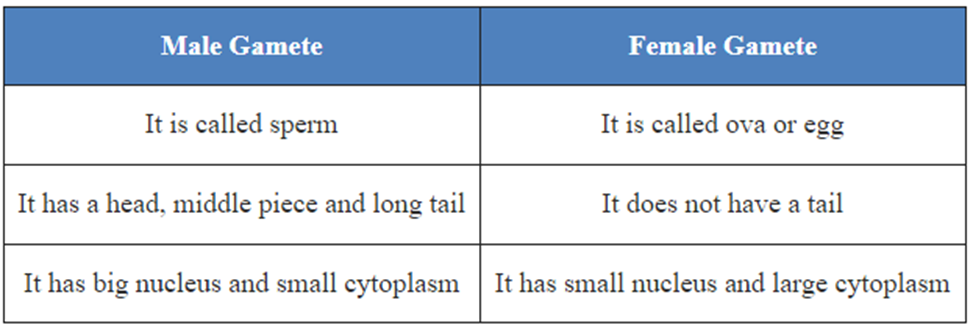
Fertilization
What is Fertilization?
- It is the fusion of male and female gametes to give rise to a single cell – zygote
- Fusion of sperm with egg to form zygote is called fertilization,
- During fertilization, the nuclei of the sperm and the nuclei of the egg fuse to form a single nucleus
- This fertilized egg is called the zygote
- The zygote is the beginning of a new individual
- Firstly, reproduction in animals begins when the sperm fuses with an ovum. This process is called Fertilization.
- The nuclei of the sperm and egg combine together and form a single nucleus.
- As a result, the zygote is formed.
- Since the zygote is formed with the fusion of male and female gametes the new individual possesses the characteristics of both the parents.
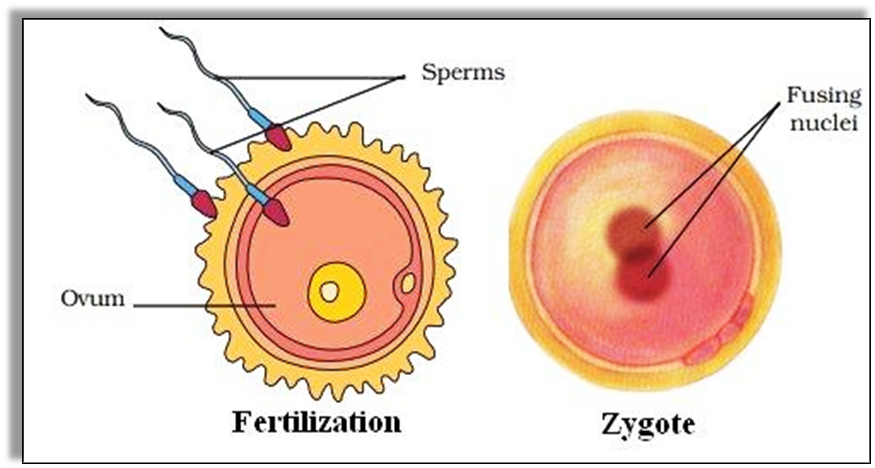
Difference between Zygote, Embryo and Foetus
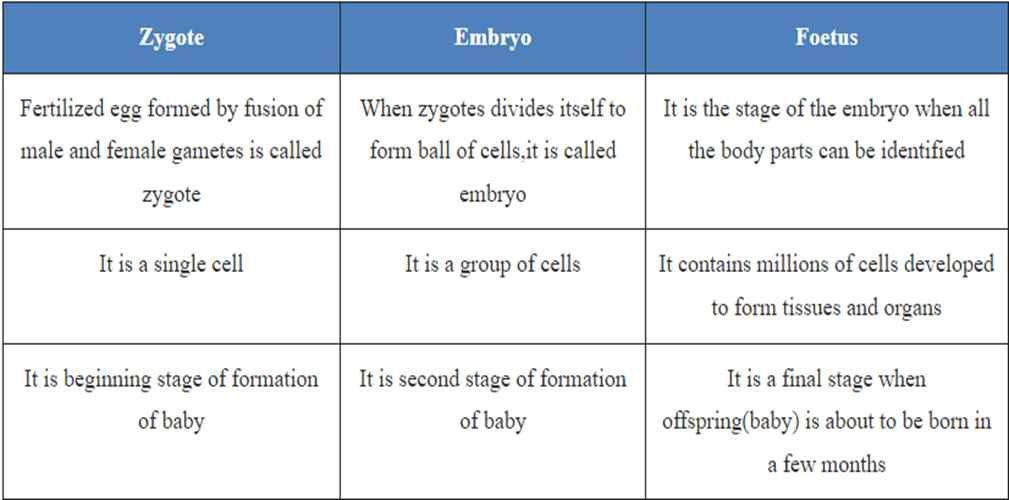
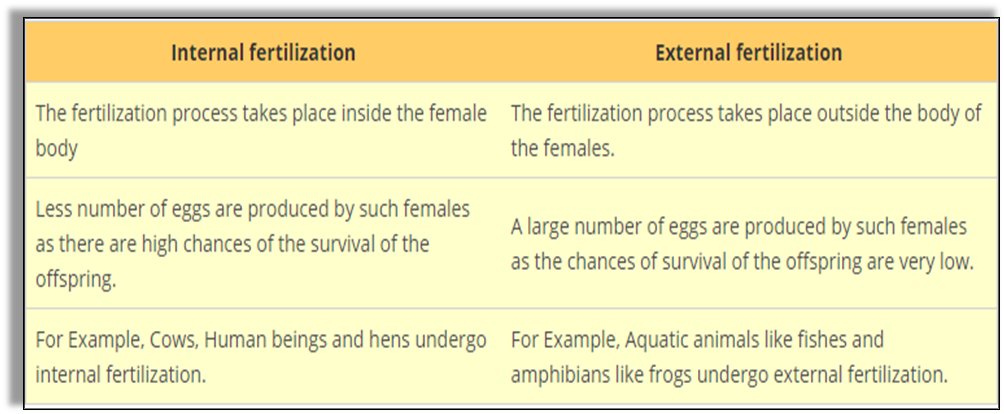
External Fertilization in Frogs and Toads
- The frogs and toads reproduce by laying eggs in a slow stream or ponds.
- The female frogs first lay hundreds of eggs together in the water.
- These eggs are not covered with any hard shell instead there is a jelly-like substance that guards them all and holds them together.
- As the female frogs lay their eggs, the male frogs deposit the sperms over them.
- This results in external fertilization when the sperms come in contact with the eggs in the water.
- Though the eggs are large in numbers only a few of them manage to survive.
- There are several factors that may hinder the fertilization process such as exposure to water movement, rainfall, winds and other animals.
Internal Fertilization in Hens
- Hens reproduce by laying eggs.
- After the formation of the zygote, it keeps on dividing itself and then travels through the oviduct.
- In this process, different layers are formed over the egg that then turns into a hard shell or covering of the egg.
- When this hard shell is formed the hen lays the egg.
- Then it takes almost 3 weeks for the embryo to develop into a chick.
- In this time period, the hen often sits over the egg to provide it with warmth.
What is IVF?
- IVF Means Invitro Fertilization or ‘in Glass Fertilization’
- In IVF, fertilization of female egg and male sperm is done artificially in a glass tube
- Baby produced through IVF is called Test tube baby
Why is IVF Done?
- Fertilization of male and female gametes happens in oviducts(fallopian tubes)
- In some females, the fallopian tubes are blocked.
- So, normal fertilization is not possible
- In this case, IVF is done for fertilization
What is Procedure for IVF?
- Eggs are removed from the ovary of females
- Sperms are taken from the husband
- Sperms are mixed with eggs in a glass dish(test tube)
- When eggs are fertilized and embryos are formed
- These embryos are placed in women’s uterus
- After some time. these embryos are developed into foetus which later develops into a baby
What are Test Tube Babies?
- In some women, the oviducts are blocked and hence they are unable to hold the eggs. This means that these women are not able to bear babies because of blocked oviducts. However, due to the process of Vitro Fertilization or IVF, the freshly released eggs of females and the male sperm can be fertilized externally.
- The zygote thus formed is allowed to develop for a week outside the female body in safe conditions and is then placed in the woman's uterus.
- In this way, these women can bear babies.
- The babies that are born with the IVF process are called Test Tube Babies.
Development of the Embryo
- The zygote formed after the fertilization process divides itself in a repeated manner and forms a ball of cells.
- These cells then form different groups and each group then starts developing into different tissues and organs. This structure is called an Embryo.
- The embryo embeds itself into the uterus wall and continues to develop and grow.
- Soon the body parts such as hands, legs, feet, eyes and ears start developing.
- The embryo whose parts can be identified individually is called a Foetus.
- The foetus then completely develops and takes birth as a baby.
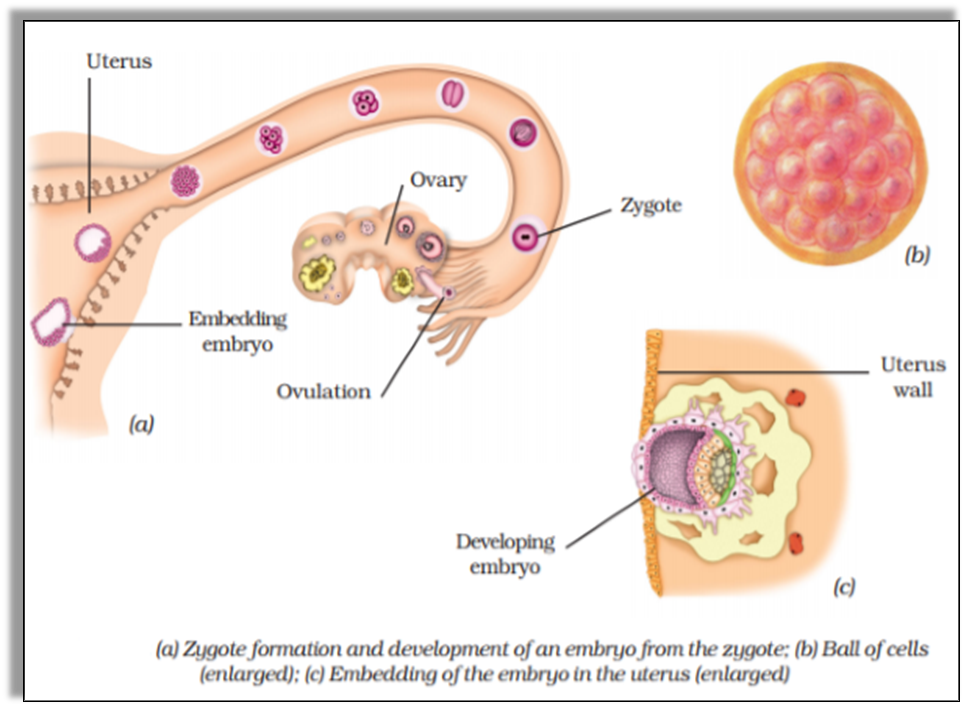
How is an embryo different from a zygote?

Based on the way how the organisms give birth to their offspring, they are classified into two categories:

What is Metamorphosis?
Metamorphosis:
The process of transformation from an immature form to an adult in two or more distinct stages is called metamorphosis. In other words, drastic changes which occur when the fertilized egg develops into an adult are called metamorphosis.
Example:- Life cycle of Frog:
Egg ----- Larva ------ Adult
Turning into adults from young ones
- As individuals are born they continue to grow until they turn into adults.
- The young ones may or may not look like the same when they become adults. For instance, in the case of frogs and silkworms, the adults and young ones are completely different.
- The process in which the young ones undergo drastic changes as they develop into an adult is called Metamorphosis.
- Human beings do not undergo metamorphosis. This is because their body parts remain the same from childhood to adulthood.
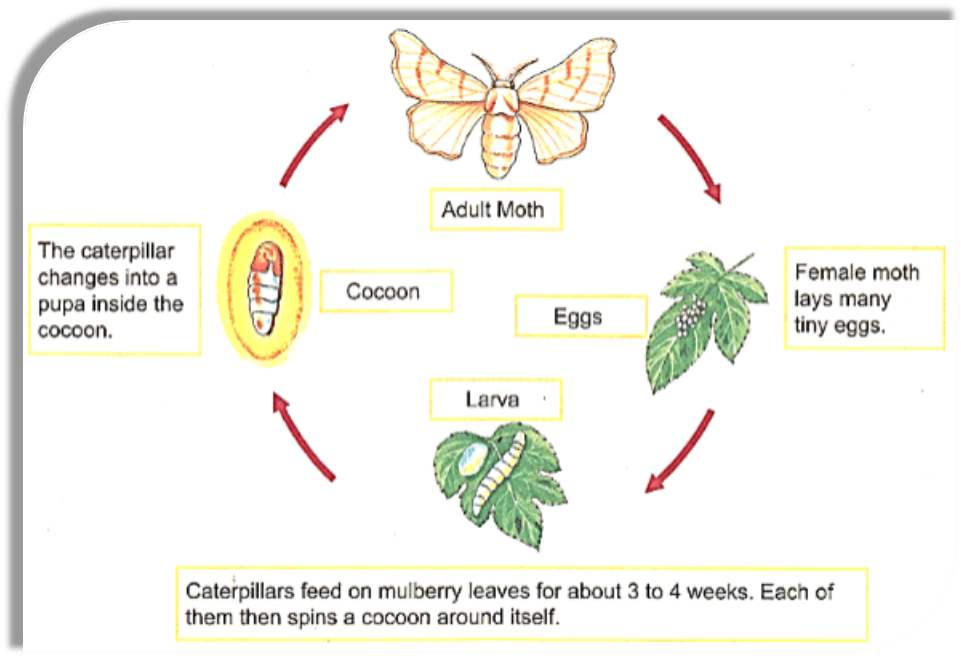
Asexual Reproduction
- Books Name
- Class-8 Science Book
- Publication
- PathSet Publications
- Course
- CBSE Class 8
- Subject
- Science
Asexual Reproduction
Asexual Reproduction in Animals
Reproduction of new organisms from a single parent, without the involvement of sex cells, is called asexual reproduction
Examples - Amoeba, Hydra
This type of reproduction involves only one parent. It takes place in microscopic animals like Amoeba and small animals like the hydra.
Budding in Hydra
- Just like yeast, reproduction in hydra takes place through the process called Budding.
- The Hydra possesses different bulges on itself called Buds.
- These buds develop into individual Hydra. Each Hydra can possess a different number of buds.
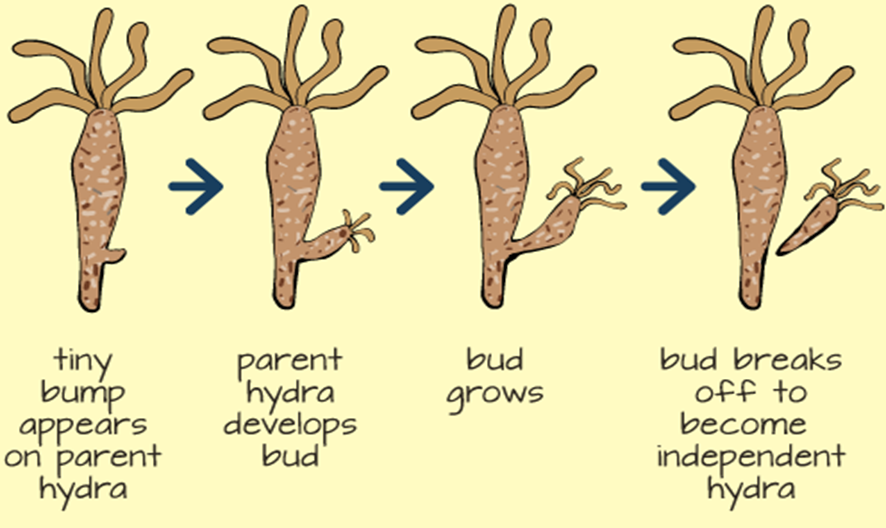
Binary Fission in Amoeba
- The Amoeba divides itself into two individuals and reproduction takes place in this way. It is called Binary Fission.
- Amoeba consists of only one cell.
- As it reproduces the nucleus of the Amoeba divides itself and forms two different nuclei.
- Then the division of the body of the Amoeba takes place and each part receives one nucleus.
- In this way, two Amoebas are produced from a single parent.
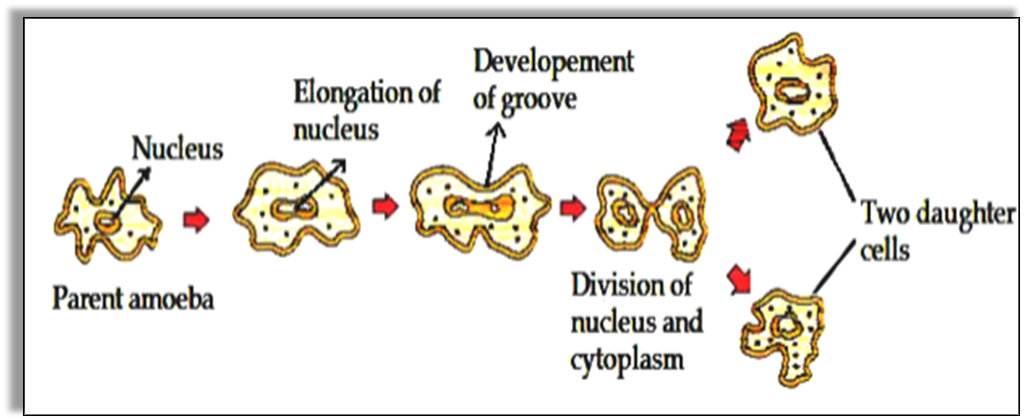
Fragmentation and Regeneration
In some organisms, the parent organism divides itself into different fragments where each fragment then regenerates and develops into a new organism. This type of asexual reproduction takes place in Planaria and Starfish. Although, starfishes are capable of sexual reproduction as well but many times they also reproduce asexually with the process of fragmentation.
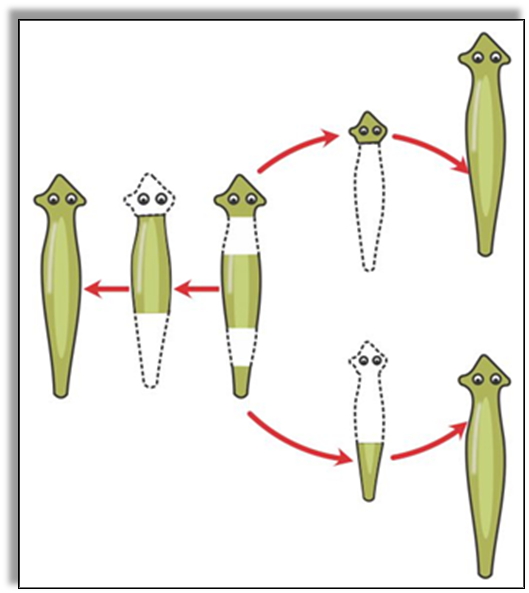
Parthenogenesis
In this type of asexual reproduction, female organisms are capable of producing eggs without fertilization. These eggs develop into a new organism. This type of reproduction can be seen in some fishes like sharks, some birds, reptiles like lizards and a few insects. However, it cannot be seen in mammals.
Difference between Sexual Reproduction & Asexual Reproduction
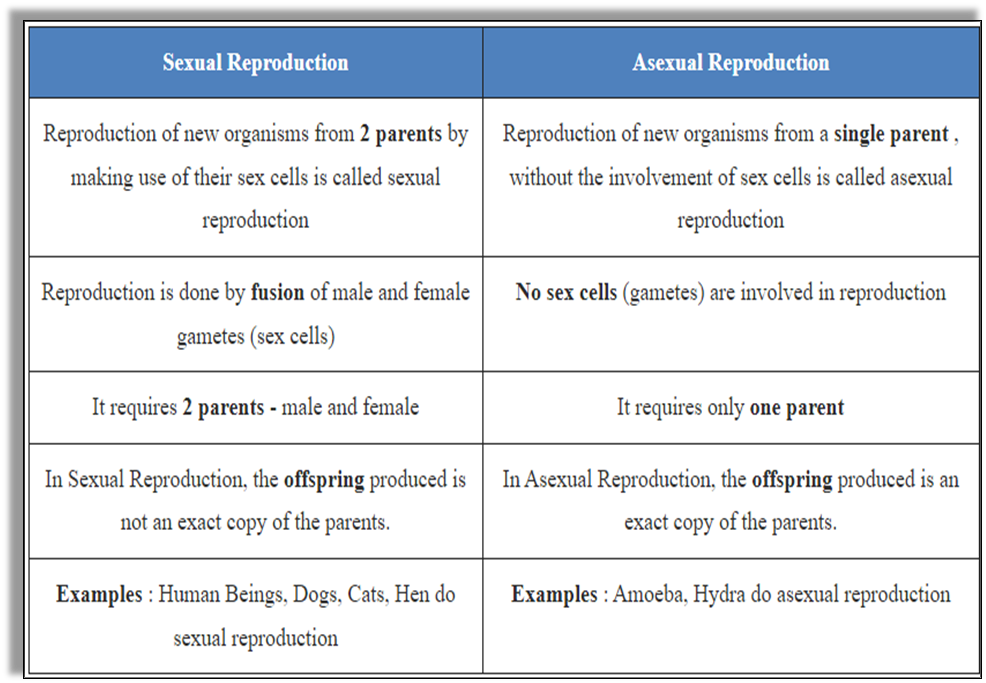
Important Terms
Asexual reproduction: The mode of reproduction in which a single organism is able to produce one or more of its kind by itself is known as asexual reproduction; e.g., Amoeba, yeast, Hydra, etc., undergo asexual reproduction.
Binary fission: The type of reproduction in which an animal reproduces by dividing into two individuals is called binary fission; e.g., Amoeba reproduces by dividing itself into two.
Budding: This kind of reproduction is seen in Hydra and yeast. It is the process of reproduction in which new individuals develop as outgrowths from a single parent. The outgrowths developed on the parent body are called buds and the process of reproduction is known as budding.
Embryo: When cells produced by the division of the zygote begin to form groups that develop into different tissues and organs of the body is called the embryo.
External fertilization: The fusion of male and female gametes takes place outside the female body. This is called external fertilization. Most aquatic animals undergo this type of fertilization.
Fertilization: The process of union of male gametes or sperms and female gametes or ova (egg) is called fertilization.
Foetus: The stage of the development of the embryo in which the development and emergence of the various body parts like the hands, the feet and eyes, etc., can be identified is called the foetus.
Internal fertilization: The fusion of male and female gametes or fertilization that takes place inside the female body is called internal fertilization. All insects, birds and mammals including human beings undergo this type of fertilization.
Metamorphosis: A biological process in which larva drastically changes into an adult in an invertebrate or amphibian during their life cycle is known as metamorphosis.
Ova or Eggs: Female gametes produced by the ovary in females are called ova or eggs.
Oviparous animals: The animals which lay eggs and hatch them to produce their young ones are called oviparous animals; e.g., frogs, butterflies, hens, crows, etc.
Reproduction: The process of producing the offspring of one’s own kind for continuity of life on the earth is known as reproduction.
Sexual reproduction: The type of reproduction that involves the fusion of male and female gametes is called sexual reproduction.
Sperms: Sperms are the male gametes produced by the testes in males.
Viviparous animals: The animals which give birth to their young ones are called viviparous animals; e.g., cow, buffalo, cat, dog, human beings, etc.
Zygote: The nucleus of the sperms and the egg fuse to form a single nucleus during the process of fertilization. The fertilized egg is called the zygote.

 PathSet Publications
PathSet Publications
